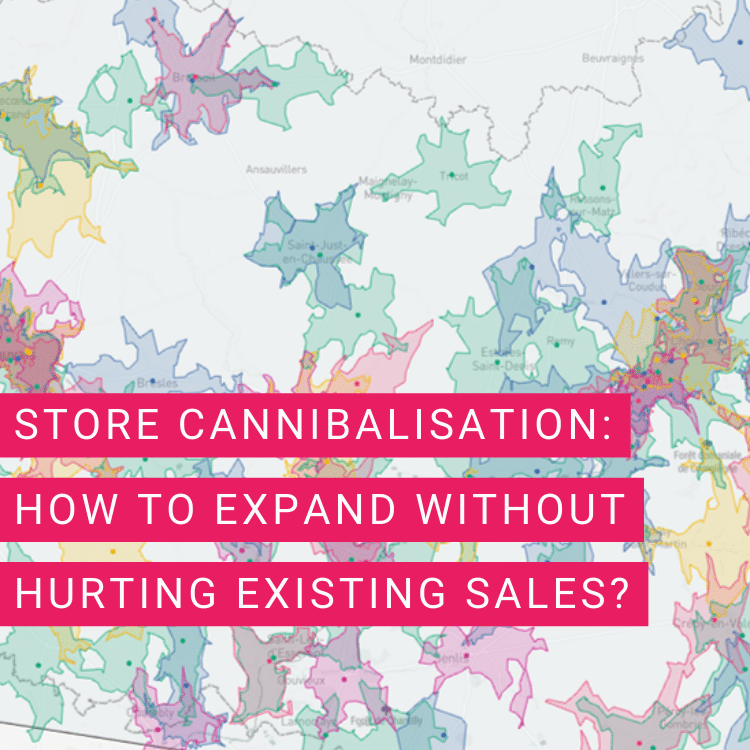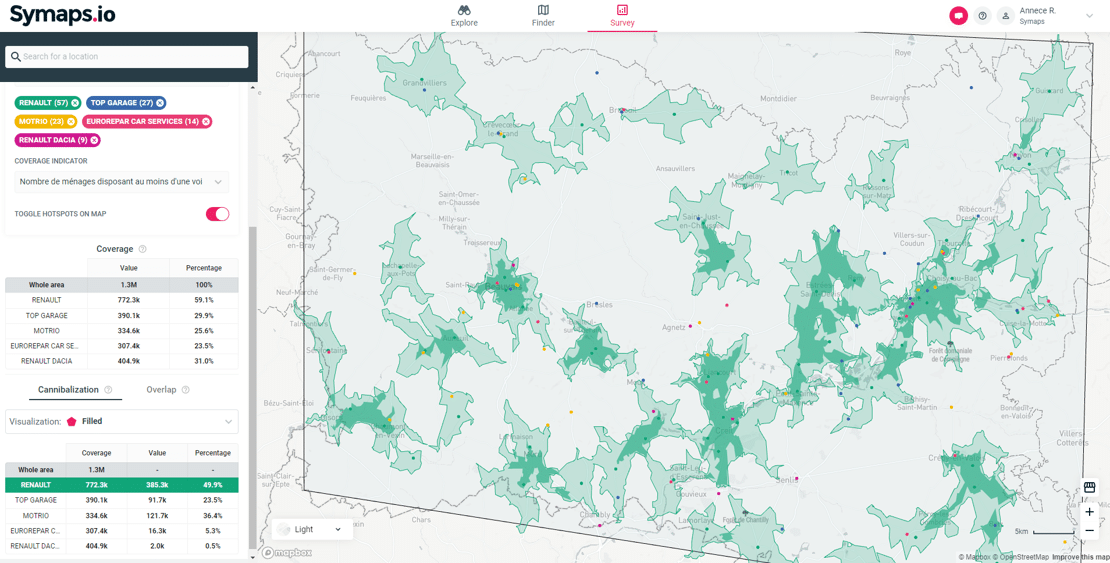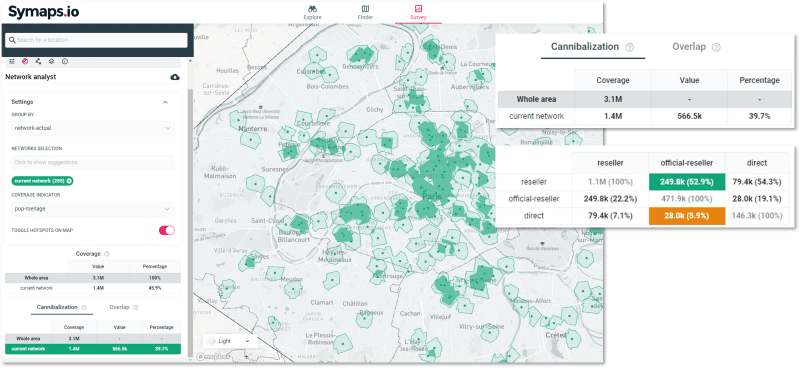Store Cannibalisation: How to Expand Your Stores Without Hurting Existing Sales
More stores mean more visibility, more sales, and ultimately, more revenue. Sounds simple, right ? But this simple view doesn’t capture the full complexity of retail expansion.
What if opening a new store unintentionally eats into the sales of an existing one?
Store cannibalisation is a concern that should be on every retailer’s radar, especially as the landscape of brick-and-mortar outlets undergoes significant evolution.

1. Store Cannibalisation: More Than Just Friendly Competition
What is store cannibalisation?
Store cannibalization refers to the reduction in sales (or traffic) experienced by an existing store due to the opening of another store from the same brand or chain in proximity.
👉 Instead of simply boosting overall sales for the brand, the new store takes a bite out of the sales pie, leading to the division of sales rather than an absolute increase.
Store cannibalization is often thought to happen mainly when stores are too close to each other, and that’s indeed the number one reason.
This competitive dynamic becomes even more pronounced when these stores offer similar products and cater to the same group of customers. And you know what adds fuel to this fire? Those big marketing campaigns that specifically zoom in on particular spots. They can end up amplifying this rivalry, sometimes inadvertently overshadowing other stores in the process.
Store cannibalisation: what are the risks?
Store cannibalization may seem benign at first—after all, sales are still within the brand. However, its long-term effects can be detrimental:
Decreased Profitability: with the operational costs of running multiple stores, if the total sales don’t proportionally increase, profitability may take a hit.
Brand Dilution: overexposure in a particular region can lead to brand fatigue, where the brand loses its ‘specialness’ due to excessive visibility.
Operational Strain: more stores mean increased logistical and operational demands, which can strain resources if sales don’t proportionally grow.
Reduced Negotiation Power: for malls or commercial real estate, having multiple underperforming stores can reduce the brand’s power to negotiate better lease terms.
2. Measuring Store Cannibalisation Effects
Spot cannibalisation areas
To promptly identify cannibalization zones, initiate by using a mapping software to visualize your network. Draw or import the catchment areas for each of your current stores. If these areas overlap, they signal potential cannibalization zones.

👉Regularly review and assess the performance of the stores within these zones to detect any shifts or trends over time. Keep a watchful eye on key performance indicators (KPIs) such as revenue, foot traffic, sales growth, and customer behavior.
Assess population and customer data
→ Calculate population in overlapping areas
One important thing to do is to figure out how many people live in the areas where the catchment areas of multiple stores overlap. In other words, how many people are being served by two or more outlets nearby?
👉 Geomarketing tools like Symaps provide the necessary technology to accurately visualise, overlay, and calculate the population within these intersecting regions, streamlining the process and ensuring precise results.
On the example below, 39.7% of the target population is served by two or more stores, either from stores of the brand or resellers. Cannibalisation is higher within reseller network, where it reaches 54.3% of the target population.
Penetration and cannibalisation rates are automatically calculated by the platform. Learn more

Monitor stores' KPIs in cannibalisation zones
Over time, keep a close watch on the key performance indicators (KPIs) to identify any shifts in performance for the stores you’ve pinpointed as potentially impacted by cannibalization effects.
Create a dedicated log or database where you document relevant data and observations related to stores with potential cannibalization effects. This record should include details about their location, catchment areas, KPIs and any strategies implemented to mitigate cannibalization.
Examples of store cannibalisation and market dynamics KPIs : revenue, foot traffic, sales growth, customer overlap, market share, loyalty, transaction value, profit margins, customer feedback, market performance.
👉In addition to data-driven approaches, seek insights from store managers and frontline staff. Consider setting up regular reviews or meetings with them to discuss the performance of stores in cannibalization zones. This collaborative approach ensures that any changes or emerging patterns are promptly addressed and that adjustments to strategies can be made in a timely manner.
3. Tackling High Store Cannibalisation: Actionable Actions to Enhance Retail Performance
Adjust product assortment
Analyse the product assortment offered at each store. Consider diversifying the product mix or introducing unique items at each location to differentiate them and reduce the potential for cannibalization.
Modify pricing strategies
Implement differentiated pricing strategies for stores with high cannibalization. Offer competitive pricing or exclusive deals to attract specific customer segments to each store, minimising the overlap in customer traffic.
Implement targeted marketing
Develop targeted marketing campaigns that highlight the distinct offerings of each store. Emphasize the unique features, products, or services available to attract customers based on preferences rather than just location.
Introduce exclusive offerings and set unique value propositions
Introduce store-exclusive products or services that can only be found at one location. Ensure that each store has a clear and distinct value proposition. This encourages customers to visit specific stores for unique offerings, reducing the cannibalization effects.
Collaboration and communication
Foster collaboration among store managers and teams. Encourage them to share insights and strategies to address cannibalization effectively and ensure a unified approach across the network.
Flexibility and adaptability
Be prepared to adjust strategies based on real-time data and customer feedback. If initial efforts don’t yield the desired results, be open to experimenting with different approaches to find the most effective solution.
Consider store consolidation
In extreme cases, consider consolidating stores if other strategies prove ineffective. While this may involve some level of downsizing, it can lead to improved overall profitability and customer experience.
Reevaluate store locations
Conduct a thorough assessment of the store locations involved. Consider whether there is excessive overlap in their catchment areas. If necessary, consider relocating one of the stores to a different area to reduce competition and minimize cannibalization.
In conclusion
When it comes to expansion, it’s about finding the right mix between growth and keeping our existing stores strong.
As brands strive to broaden their reach and amplify sales, they’re also confronted with the challenge of preserving the individuality and vitality of each store.
The juxtaposition of these objectives raises intriguing questions: How to strike the right balance between growth and sustainability? How to ensure that every new venture enhances the collective retail ecosystem without overshadowing existing successes?
This discussion opens the door to a broader exploration of the dynamic interplay between expansion and cannibalisation.
About Symaps
Symaps offers a complete solution for site selection, location planning, and expansion strategy. Our services cater to diverse industries, including retail, luxury, restaurants, car charging stations, and more. We empower businesses with precise, data-driven insights to make informed decisions regarding their brick-and-mortar investments.
Reach out to us if you need a tool to assist you in finding the best location for your business or analysing your footprint.
Book a Call and a Free Demo
Contact Us Today!
- Let’s talk about your project by phone
- Get a personalised live demo
- Learn more on how to save time and money for your location decisions thanks to Symaps’ AI based solution
Share post
